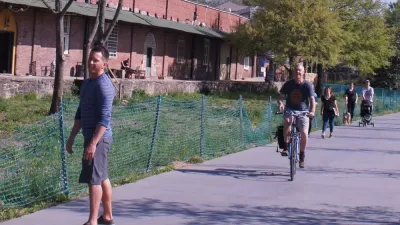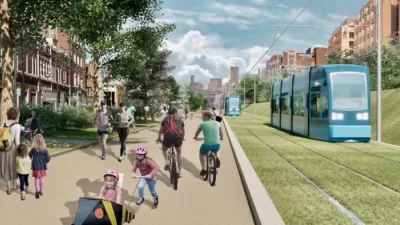The tax allocation district set up to capture development value created by the Atlanta BeltLine has fallen short of its intended goals for creating and preserving affordable housing.
Emily Nonko reports on efforts to ensure equitable development around the Atlanta BeltLine—one of the largest and most ambitious public open space investments in the United States.
While the BeltLine has already proven immensely popular, questions about equity, gentrification, and displacement have dogged the project for years now, especially in the tax allocation district set up to fund affordable housing projects. As Nonko notes, "in 2016, the BeltLine’s original visionary resigned from the partnership’s board, citing concerns about equitable development. Last year, a report from the Atlanta Journal-Constitution and Georgia News Lab found only 785 of the 5,600 units had been funded, reporting that the 'mission of keeping black families and middle and low-income residents from being pushed from their neighborhoods became an afterthought to building parks and trails.'"
Nonko reports that Atlanta BeltLine Inc. is working to better achieve goals of equity and ensuring inclusive developments within the tax allocation district. To that end, the organization recently released a report [pdf] on the subject of creating and preserving affordable housing. The report sets a goal of 5,600 affordable units. Nonko reports on the details of the report, and the challenges facing Atlanta BeltLine Inc. in achieving the ambitions of the tax allocation district.
FULL STORY: Resetting The Atlanta BeltLine’s Focus on Equitable Development

Alabama: Trump Terminates Settlements for Black Communities Harmed By Raw Sewage
Trump deemed the landmark civil rights agreement “illegal DEI and environmental justice policy.”

Planetizen Federal Action Tracker
A weekly monitor of how Trump’s orders and actions are impacting planners and planning in America.

The 120 Year Old Tiny Home Villages That Sheltered San Francisco’s Earthquake Refugees
More than a century ago, San Francisco mobilized to house thousands of residents displaced by the 1906 earthquake. Could their strategy offer a model for the present?

In Both Crashes and Crime, Public Transportation is Far Safer than Driving
Contrary to popular assumptions, public transportation has far lower crash and crime rates than automobile travel. For safer communities, improve and encourage transit travel.

Report: Zoning Reforms Should Complement Nashville’s Ambitious Transit Plan
Without reform, restrictive zoning codes will limit the impact of the city’s planned transit expansion and could exclude some of the residents who depend on transit the most.

Judge Orders Release of Frozen IRA, IIJA Funding
The decision is a victory for environmental groups who charged that freezing funds for critical infrastructure and disaster response programs caused “real and irreparable harm” to communities.
Urban Design for Planners 1: Software Tools
This six-course series explores essential urban design concepts using open source software and equips planners with the tools they need to participate fully in the urban design process.
Planning for Universal Design
Learn the tools for implementing Universal Design in planning regulations.
Clanton & Associates, Inc.
Jessamine County Fiscal Court
Institute for Housing and Urban Development Studies (IHS)
City of Grandview
Harvard GSD Executive Education
Toledo-Lucas County Plan Commissions
Salt Lake City
NYU Wagner Graduate School of Public Service





























